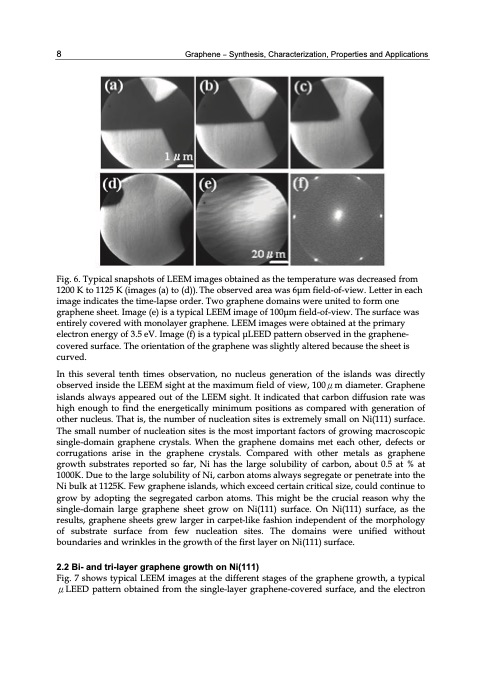PDF Publication Title:
Text from PDF Page: 018
8 Graphene – Synthesis, Characterization, Properties and Applications Fig. 6. Typical snapshots of LEEM images obtained as the temperature was decreased from 1200 K to 1125 K (images (a) to (d)). The observed area was 6μm field-of-view. Letter in each image indicates the time-lapse order. Two graphene domains were united to form one graphene sheet. Image (e) is a typical LEEM image of 100μm field-of-view. The surface was entirely covered with monolayer graphene. LEEM images were obtained at the primary electron energy of 3.5 eV. Image (f) is a typical μLEED pattern observed in the graphene- covered surface. The orientation of the graphene was slightly altered because the sheet is curved. In this several tenth times observation, no nucleus generation of the islands was directly observed inside the LEEM sight at the maximum field of view, 100μm diameter. Graphene islands always appeared out of the LEEM sight. It indicated that carbon diffusion rate was high enough to find the energetically minimum positions as compared with generation of other nucleus. That is, the number of nucleation sites is extremely small on Ni(111) surface. The small number of nucleation sites is the most important factors of growing macroscopic single-domain graphene crystals. When the graphene domains met each other, defects or corrugations arise in the graphene crystals. Compared with other metals as graphene growth substrates reported so far, Ni has the large solubility of carbon, about 0.5 at % at 1000K. Due to the large solubility of Ni, carbon atoms always segregate or penetrate into the Ni bulk at 1125K. Few graphene islands, which exceed certain critical size, could continue to grow by adopting the segregated carbon atoms. This might be the crucial reason why the single-domain large graphene sheet grow on Ni(111) surface. On Ni(111) surface, as the results, graphene sheets grew larger in carpet-like fashion independent of the morphology of substrate surface from few nucleation sites. The domains were unified without boundaries and wrinkles in the growth of the first layer on Ni(111) surface. 2.2 Bi- and tri-layer graphene growth on Ni(111) Fig. 7 shows typical LEEM images at the different stages of the graphene growth, a typical μLEED pattern obtained from the single-layer graphene-covered surface, and the electronPDF Image | GRAPHENE SYNTHESIS CHARACTERIZATION PROPERTIES

PDF Search Title:
GRAPHENE SYNTHESIS CHARACTERIZATION PROPERTIESOriginal File Name Searched:
Graphene-Synthesis.pdfDIY PDF Search: Google It | Yahoo | Bing
Salgenx Redox Flow Battery Technology: Power up your energy storage game with Salgenx Salt Water Battery. With its advanced technology, the flow battery provides reliable, scalable, and sustainable energy storage for utility-scale projects. Upgrade to a Salgenx flow battery today and take control of your energy future.
CONTACT TEL: 608-238-6001 Email: greg@infinityturbine.com (Standard Web Page)